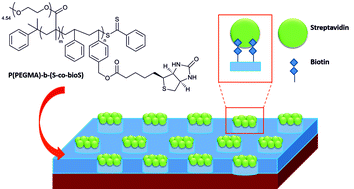Synthesis of a polymethyl(methacrylate)-polystyrene-based diblock copolymer containing biotin for selective protein nanopatterning†
Abstract
Protein patterning is of interest in high-throughput screening. Due to an increase in demand for further miniaturization of protein assays, block copolymers (BCPs) that can undergo large-area phase separation into nanometer-size domains have attracted great attention as substrates for protein nanopatterning. Here we report the synthesis of a polymethyl(methacrylate)-polystyrene-based diblock copolymer which, once spin-coated, is capable of self-segregating into cylindrical polystyrene (PS) domains. In this copolymer, the PS block was modified to introduce biotin below 10% molar in order to achieve molecular recognition of streptavidin. The PMMA matrix used to introduce poly(ethylene glycol) enabled us to obtain an antifouling environment that prevents unspecific protein adsorption outside the domains. The use of the biotin–streptavidin pair in this BCP makes it suitable for nanopatterning of other biotinylated proteins of interest for the purposes of cell biology, biosensors, and tissue engineering.


 Please wait while we load your content...
Please wait while we load your content...